Pentland Firth Orkney Waters Marine Spatial Plan: Value Added in the Fish Supply Chain in Orkney and Northern Highlands
This report is the one of a suite of evidence documents that will support Stage 2 of the development of a pilot Pentland Firth and Orkney Waters Marine Spatial Plan. . This report estimates the value of marine species caught in the Pentland Firth and Orkn
Section 1: Overview of Fishing Activity
Species landed from PFOW Strategic Area and surrounding waters
Throughout this report PFOW refers to the region in general and includes all activities that take place in all waters in the area that potentially impacts on Orkney and the Northern Highlands. PFOW-SA refers specifically to the Strategic Area which for the propose of this study is used as a proxy for the area in the pilot marine plan (base on Annex 1 - yet to be finalised). For this report PFOW-SA is depicted as the pale blue area with extends out to the 12nm line in Figure 1 and spans 5 ICES rectangles [1] . Since this analysis, this area has been redefined and the area used by the pilot MSP is based on the Scottish Marine Regions of Orkney and North Coast (see Annex 1). Whilst these boundaries are yet to be confirmed, this analysis does not include fishing activity on the Orkney Skerries or the west of the Northern Highlands, therefore this analysis could be underestimating the impact to the region.
To quantify the links between fishing activity and associated onshore activity three data sets were combined to accurately map where marine species were caught and landed into Orkney and the Northern Highlands. The first data set maps activity of over 15m vessels through a Vessel Monitoring System ( VMS). The second data set maps under 15m vessel activity through ScotMap (a mapping programme) and both are linked to the third data set, the Fisheries Information Network ( FIN), the official government database used to extract volume and values of UK fisheries (see Annex 2 - Methods for further details). To reduce the complexity of the picture this analysis focuses on the top 11 ports ( Fig. 2), from a total of 19 active ports in the region - this accounted for 99.8% of landings into the two districts and all analysis is on these 11 ports only.
Figure 2: Eleven Key Port in Orkney and Northern Highaland
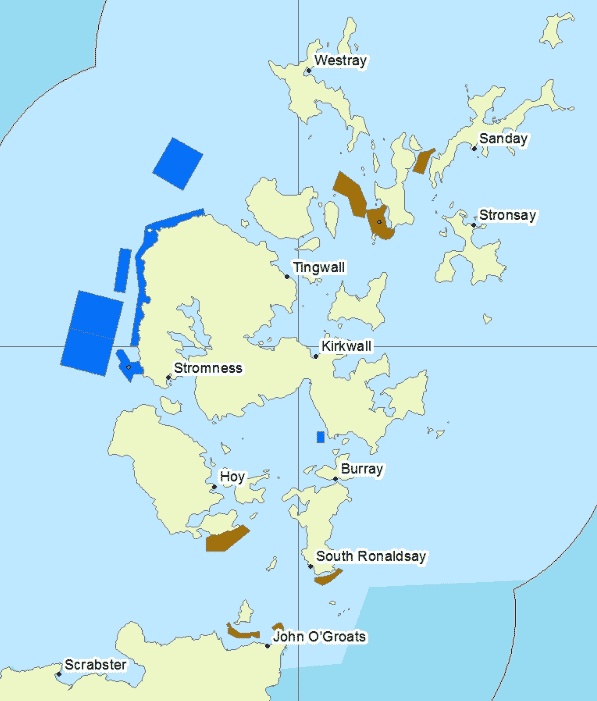
Figure 3: Total volume of landing into 11 key ports from PFOW and surrounding waters
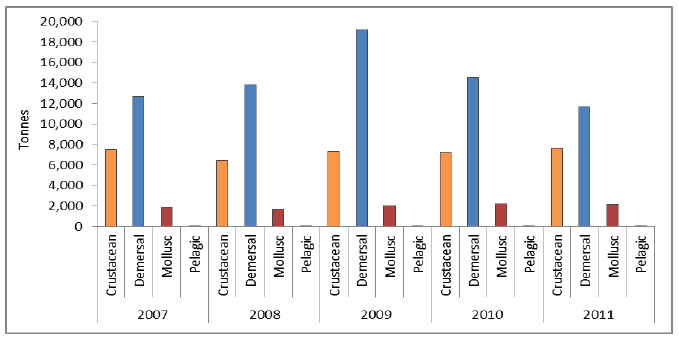
Figure 4: Total value of landings (2011 prices) into 11 key ports from PFOW and surrounding waters
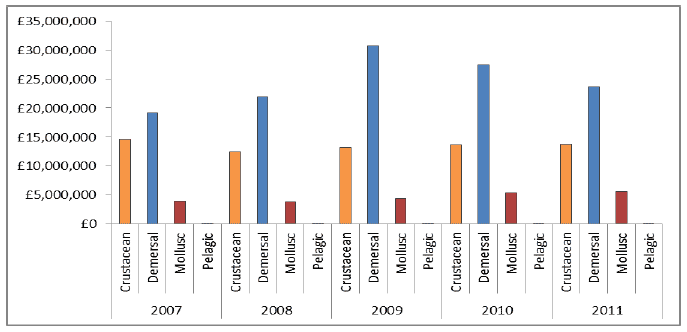
Landings into Orkney and the Northern Highlands are dominated by demersal and crustacean species. By volume demersal species make up the bulk and ranged from 11,706 to 19,215 tonnes between 2007 and 2011 ( Fig. 3). Crustaceans follow, having remained steady and range from 6,419 to 7,660 tonnes and molluscs are also constant over the period at around 2,000 tonnes per year. By value demersal are the highest value group, however crustaceans gain a little in value due to the relativity high price per kg ( Fig. 4).
To conduct a detailed study on fish landings and their links to onshore activity the rest of this report focuses on 2011 fishing activity [2] to profile the fleet composition and vessels contributing to regional landings. Using VMS and ScotMap, spatial activity was mapped and quantities estimated for vessels over and under 15 metres in length. Table 1 presents total landings of £42.9 million in 2011 - £36.8 million (18,878 tonnes) came from the over 15m fleet and £6.1 million (2,681 tonnes) from the under 15m fleet. For the over 15m vessels this was dominated by demersal landings followed by crustaceans and for the under 15m vessels this was dominated by crustaceans with a small amount from molluscs.
Table 1: Total value and volume into 11 key ports by species type for over and under 15m vessels and percentage which come from inside PFOW-SA
| PFOW-SA and Surrounding waters | PFOW-SA only | % from inside PFOW-SA | ||||
|---|---|---|---|---|---|---|
| Value | Volume (ton) | Value | Volume (ton) | Value | Volume | |
| Over 15m vessels | ||||||
| Crustaceans | £8,570,715 | 5,365.8 | £234,824 | 128.2 | 2.7 | 2.4 |
| Demersal | £23,577,239 | 11,689.0 | £1,174,971 | 732.9 | 5.0 | 6.3 |
| Molluscs | £4,655,205 | 1,809.8 | £391,311 | 189.6 | 8.4 | 10.5 |
| Pelagic | £11,995 | 13.3 | £365 | 0.2 | 3.0 | 1.5 |
| All species | £36,815,154 | 18,877.9 | £1,801,470 | 1,051.1 | 4.9 | 5.6 |
| Under 15m vessels | ||||||
| Crustaceans | £5,114,626 | 2,283.2 | £4,620,035 | 2,064.4 | 90.3 | 90.4 |
| Demersal | £51,027 | 16.9 | £1,724 | 1.2 | 3.4 | 7.2 |
| Molluscs | £942,313 | 361.0 | £917,087 | 350.7 | 97.3 | 97.1 |
| Pelagic | £9,501 | 9.4 | £9,039 | 8.9 | 95.1 | 95.4 |
| All species* | £6,117,467 | 2,681.4 | £5,597,141 | 2,450 | 91.5 | 91.4 |
| Total all species | £42,932,621 | 21,559.3 | £7,398,611 | 3,501.1 | 17.2 | 16.2 |
* figure does not match total of species for the under 15m vessels as some landings are excluded
Overall 17% of the value of landings into the region came from PFOW-SA and 16% of volume. However the proportion of catch by vessel length differs significantly with 5.6% of volume (4.9% of value) coming from inside PFOW-SA for the over 15m fleet, but over 90% of landings for the under 15m excluding demersal species which is substantially lower ( table 1). This indicates little impact would be felt by the over 15m fleet from reduced fishing opportunity in the PFOW-SA, but the under 15m vessels are more dependent on these waters through the landings of crustaceans ( Fig. 5).
Figure 5: Value of species type landed into 11 key ports from under 15m (left) and over 15m (right) vessels from inside PFOW-SA (blue) and outside PFOW-SA (red).

Figure 6: Number of vessels by proportion (%) of landings coming from inside PFOW by under (left) and over 15m (right) vessels. Data for under 15m vessels' mean value from 2006- 2011, for over 15m vessels data from 2011 landings.

This is further supported by plotting the proportion of landings coming from inside PFOW-SA for both fleets which demonstrates that 124 vessels in the under 15m fleet catch over 99% of their landings from inside PFOW-SA, whilst only 1 over 15m vessel catches over 99% from inside PFOW-SA ( Fig. 6). It is worth noting that of the registered 141 under 15m vessels, not all are working full time and include hobby fishing and partially active vessels.
Spatial activity of PFOW-SA vessels
To understand the islands and isolated regions dependence on landings and the links to onshore fish processing activities the geographical spread of landings from inside and outside PFOW-SA were plotted for over 15m and under 15m vessels in 11 key ports ( Fig. 7). This illustration shows that the majority of landings in 2011 came into Scrabster, Stromness and Kirkwall and the bulk of landings into the first two ports come from outside PFOW by over 15m vessels ( Fig. 7). For Kirkwall just over half of the value is from over 15m vessels. Landings caught from inside PFOW-SA by the over 15m fleet came into Sanday and Scrabster (see Fig. 7) probably due to the strategic location of these ports or proximity to good crustacean grounds from Sanday ( Fig. 9) and mollusc grounds for Scrabster ( Fig. 10).
Figure 7: Value of landings broken down by under and over 15m vessels from inside and outside PFOW-SA.
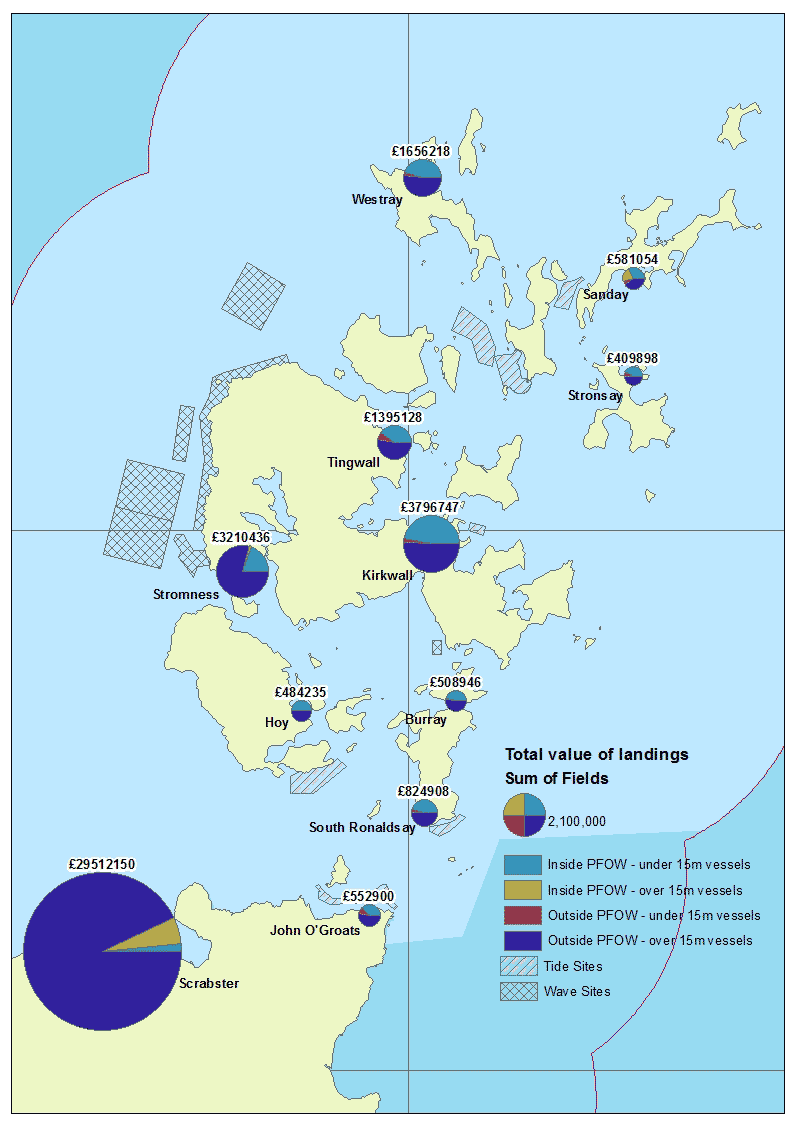
Almost all Orkney ports with the exception of Stromness received around 50% of their landings from the under 15m fleet from inside PFOW-SA. A small proportion of the under 15m vessels land catch from outside PFOW-SA which are landed into the northern ports (Westray, Sanday, Stronsay, Tingwall and Kirkwall) and two southern ports (John O'Groats and South Ronaldsay).
The following maps (Fig. 8- 10) show the distribution and value of landings by species, excluding pelagic due to low landings into the area. All demersal landings went to Scrabster (~£23 million) with the exception of Stromness where over 15m vessels landed around £81,000 and under 15m a modest £1,400 ( Fig. 8). This shows that Orkney has no direct dependency on demersal species, but this species type is very important to the Northern Highlands.
Figure 8: Value of demersal landings by under (left) and over 15m (right) vessels into PFOW-SA key 11 ports. Size of pie charts represent variations in the value of landings
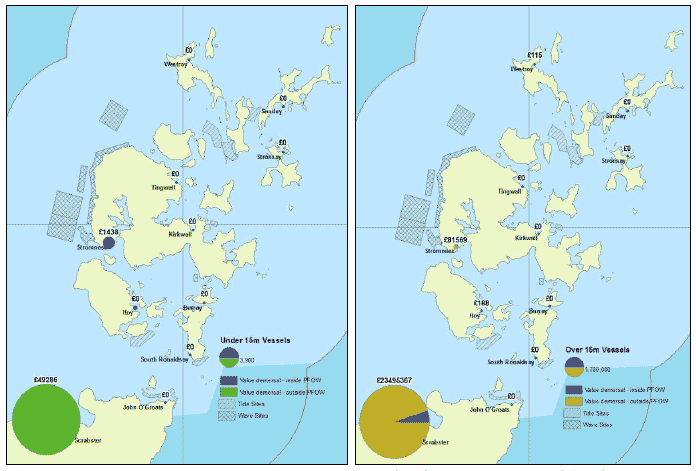
Figure 9: Value of crustaceans landings by under (left) and over 15m (right) vessels into PFOW-SA key 11 ports. Size of pie charts represent variations in the value of landings
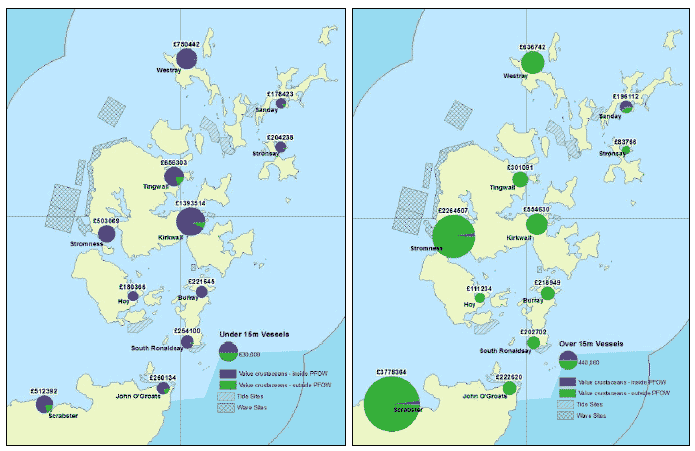
Figure 10: Value of mollusc landings by under (left) and over 15m (right) vessels into PFOW-SA key 11 ports. Size of pie charts represent variations in the value of landings
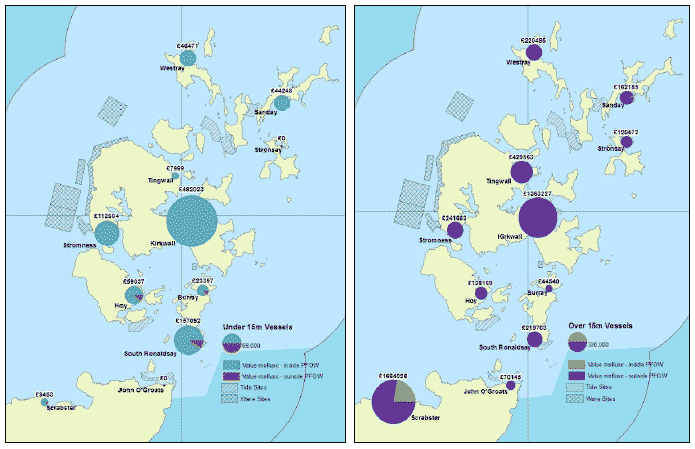
Crustacean landings are spread throughout the PFOW region with the higher landed values going into Scrabster (£3.8 million), Stromness (£2.3 million), Westray and Kirkwall (around £600,000) by the over 15m vessels. For the under 15m vessels the bulk is landed into Kirkwall (£1.4 million) and then spread throughout the west coast of Orkney with Westray and Tingwall landing around £700,000 and Stromness and Scrabster about £600,000. Of these landings the majority comes from inside PFOW-SA.
For molluscs, landings are also spread throughout the region with the bulk of the landings from the under 15m vessels coming from inside PFOW-SA and for the over 15m vessels coming from outside. The southern ports have some landings by the under 15m fleet from outside PFOW-SA, where only Scrabster has over 15m vessels landing from inside PFOW-SA. Of these ports Scrabster (£1.7 million) and Kirkwall (£1.4 million) receive most of the catch from over 15m vessels and Kirkwall receives most of the catch for the under 15m vessels (£480,000).
Contact
There is a problem
Thanks for your feedback